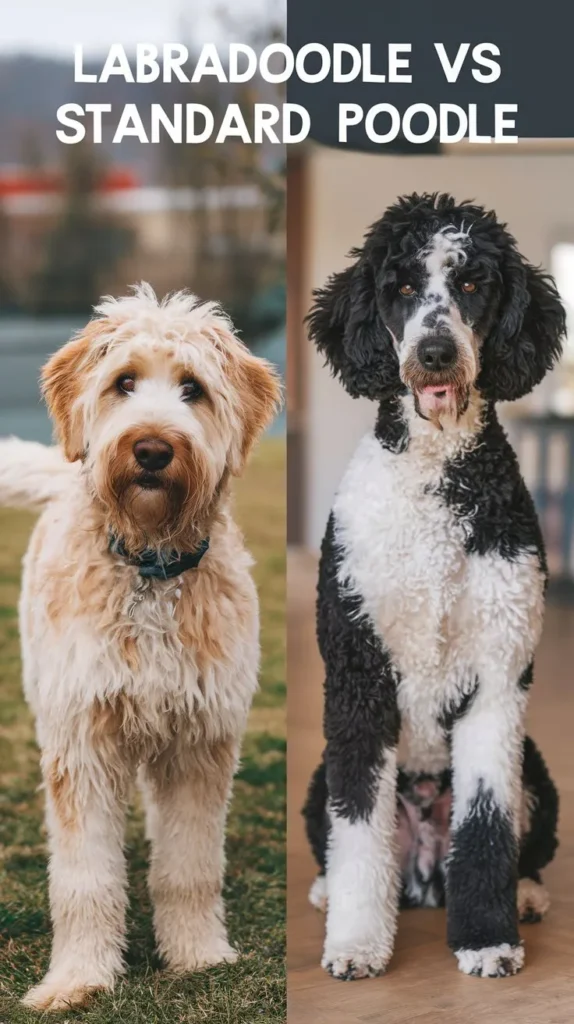Labradoodle Vs Standard Poodle: Grooming, Training, and Health Compared
As you weigh the pros and cons of bringing a Labradoodle or Standard Poodle into your life, you’ll want to ponder the key differences between these popular breeds. Both are intelligent and trainable, but their exercise needs and energy levels set them apart.
You might be drawn to the Labradoodle’s friendly, outgoing nature, but can you commit to their daily hour-long walks?
Or perhaps the Standard Poodle’s more moderate energy level appeals to you, but are you prepared to tackle their high-maintenance grooming? The choice isn’t easy, but understanding their unique characteristics will help you make an informed decision that’s right for you – and your new furry friend.
In a Nutshell

- Labradoodles combine the friendly nature of Labradors with the intelligence and low-shedding coat of Standard Poodles, making them a popular choice for those with allergies.
- Standard Poodles are highly intelligent, agile, and trainable, originating from Germany as water retrievers and performers in circuses and theaters.
- Labradoodles inherit the high-energy trait from their Labrador parent, requiring at least an hour of exercise daily, whereas Standard Poodles have a more moderate energy level.
- Both breeds require early socialization to develop good manners and a calm demeanor, with proper socialization helping to manage social anxiety and fear-based behaviors.
Origins of the Labradoodle

As you plunge into the world of Labradoodles, you might wonder where this breed came from.
Bred in the 1980s by Wally Conron, an Australian breeder, the Labradoodle was originally intended to create a hypoallergenic guide dog by crossing a Labrador Retriever with a Standard Poodle.
This innovative idea sparked a series of breeding experiments, aiming to produce a dog that would be both intelligent and low-shedding.
The resulting offspring, dubbed ‘designer dogs,’ were meant to cater to people with allergies who still wanted to experience the joy of dog ownership.
These early experiments led to the development of the Labradoodle as it stands today.
By combining the friendly, outgoing nature of the Labrador Retriever with the intelligence and low-shedding coat of the Standard Poodle, Conron created a breed that wasn’t only hypoallergenic but also highly trainable and affectionate.
As you explore the world of Labradoodles, you’ll discover that these dogs are more than just a sum of their parts – they’re a tribute to the power of innovative breeding and the pursuit of freedom from allergies.
Standard Poodle History

You can trace the origins of the Standard Poodle back to Germany over 400 years ago, where they emerged as water retrievers and performers in circuses and theaters.
As a versatile breed, they were highly valued for their intelligence, agility, and trainability. The Standard Poodle’s ancestors were likely water dogs, with ancient roots dating back to the 15th century.
These Poodle ancestors were bred to retrieve game for hunters, with their distinctive coat helping them to blend in with their surroundings.
Over time, the Standard Poodle’s role expanded to include circus and theater performances, where they wowed audiences with their acrobatic feats and clever tricks.
Their intelligence, athleticism, and charisma made them a natural fit for the spotlight. As the breed developed, they became known for their signature pom-poms and dignified demeanor, earning them a reputation as a sophisticated and elegant breed.
Today, the Standard Poodle remains a beloved companion and performer, cherished for their unique history, intelligence, and charm.
Temperament Comparison

When comparing the temperaments of Labradoodles and Poodles, you’ll want to weigh three key aspects: their energy levels, trainability and intelligence, and socialization needs.
As you evaluate these factors, you’ll get a better sense of which breed is the best fit for your lifestyle and living situation.
Energy Level Comparison
Comparing the energy levels of Labradoodles and Poodles reveals distinct differences in their temperament, with Labradoodles typically inheriting the high-energy trait from their Labrador Retriever parent. As someone who’s considering bringing one of these breeds into your life, it’s vital to understand their energy needs to provide the necessary exercise and stimulation.
If you lead a high-energy lifestyle and enjoy urban exercise routines like jogging or cycling, a Labradoodle might be the perfect companion. They require at least an hour of exercise daily, and their high energy levels make them ideal for active owners.
On the other hand, Standard Poodles have a more moderate energy level, requiring around 30-60 minutes of exercise daily. They’re better suited for owners who prefer shorter, more leisurely walks.
When considering a Labradoodle or Poodle, it’s pivotal to assess your lifestyle and energy levels to confirm you can meet their needs. If you’re an urban dweller who enjoys staying active, a Labradoodle might be the perfect fit.
However, if you prefer a more relaxed pace, a Standard Poodle could be a better match.
Trainability and Intelligence
Both Labradoodles and Poodles are renowned for their exceptional intelligence, with the former inheriting the trainability and problem-solving skills of their Labrador Retriever parent and the latter boasting a reputation as one of the smartest breeds, ranking second only to Border Collies in terms of canine intelligence.
As you consider bringing one of these breeds into your life, you’ll want to understand their trainability and intelligence.
You’ll find that both Labradoodles and Poodles are highly trainable, responding well to positive reinforcement and clear commands.
They excel in command learning, quickly picking up on cues and tasks.
Their problem-solving skills are also impressive, allowing them to adapt to new situations and think critically.
With consistent training and socialization, you can tap into their full potential and enjoy a strong bond with your pet.
Whether you’re an experienced dog owner or a newcomer, you’ll appreciate the ease with which these breeds learn and respond to commands.
Socialization Needs
Your new pet’s temperament will greatly benefit from early socialization, as Labradoodles and Poodles require careful exposure to various environments, people, and situations to develop good manners and a calm demeanor.
Socialization is vital in helping them recognize and respond to social cues, such as body language and vocal signals.
This will enable them to interact confidently with strangers, other pets, and new environments.
Proper socialization also helps your pet manage social anxiety, which can lead to fear-based behaviors or aggression if left unaddressed.
By exposing your Labradoodle or Poodle to different stimuli, you’ll help them develop emotional resilience and adaptability.
This, in turn, will enable them to handle unexpected situations and changes with ease.
As a responsible pet owner, key to their development is to prioritize socialization from an early age.
You can do this by enrolling your pet in puppy socialization classes, hosting playdates, and gradually introducing them to new environments and experiences.
Intelligence and Trainability

When evaluating the intelligence and trainability of Labradoodles and Poodles, it’s crucial to examine their working heritage, as both breeds were originally bred to perform specific tasks that required high cognitive abilities and responsiveness to commands. You’ll find that both breeds excel in these areas, making them highly intelligent and trainable.
| Breed | Cognitive Abilities | Problem Solving Capacity |
|---|---|---|
| Labradoodle | Exceptional memory and attention span, making them quick learners | Excellent problem solvers, able to adapt to new situations |
| Standard Poodle | Highly intelligent, with a strong work ethic and desire to please | Superior problem solvers, known for their ability to think critically |
As you can see, both breeds possess exceptional cognitive abilities and problem-solving capacity. This means you can expect them to learn quickly and respond well to commands.
With consistent training and positive reinforcement, you can tap into their full potential and develop a strong bond with your dog.
Whether you’re a seasoned dog owner or a first-time pet parent, you’ll appreciate the ease of training and the joy of having a highly intelligent companion by your side.
Energy Levels and Exercise

When considering a Labradoodle or Poodle as a pet, you’ll want to assess their daily activity needs and exercise requirements to guarantee you can provide the necessary physical and mental stimulation.
Both breeds require regular exercise to stay happy and healthy, but their energy levels differ.
You’ll need to understand these differences to determine which breed is the best fit for your lifestyle and living situation.
Daily Activity Needs
Both Labradoodles and Poodles require regular exercise to meet their daily activity needs, with varying energy levels influencing the type and duration of physical activity they need.
As you consider bringing one of these breeds into your life, to guarantee a harmonious relationship, you must comprehend their daily activity needs to certify you can provide the necessary exercise and mental stimulation.
To meet their daily activity needs, you’ll want to establish a routine that includes:
- Morning routines: A 30-minute walk or playtime to get their energy out and set a positive tone for the day
- Mid-day breaks: Short, 10-15 minute breaks for stretching, play, or training to keep them engaged and active
Exercise Requirements Compared
You’ll need to tailor your exercise routine to your dog’s energy level, as Labradoodles and Poodles have distinct exercise requirements that cater to their unique characteristics.
Labradoodles, being high-energy breeds, require more strenuous exercise to keep them physically and mentally stimulated. They thrive on playtime routines that involve running, swimming, or agility training, which help burn off excess energy. Aim for at least 60-90 minutes of moderate to high-intensity exercise daily.
In contrast, Standard Poodles are more laid-back and require less intense exercise. They still need regular physical activity, but shorter, more gentle sessions suffice.
A 30-60 minute walk or low-impact playtime is ideal. However, they do appreciate outdoor adventures, such as hiking or playing fetch, which provide mental stimulation and exercise.
Grooming Needs and Style

Your Labradoodle or Poodle requires regular grooming to prevent matting and tangling, as their thick, curly coats trap dirt and debris. To maintain their stylish look, you’ll need to commit to a regular grooming routine. This is especially important for Labradoodles, whose fur texture is often softer and more prone to matting than Standard Poodles.
Some key aspects to ponder when it comes to their grooming needs:
Curl maintenance: Regular brushing is essential to prevent curls from forming tight knots. Use a slicker brush or a pin brush to gently work out tangles and prevent matting.
Fur texture: Labradoodles tend to have a softer, thicker coat than Standard Poodles, which requires more frequent brushing to prevent matting.
Grooming frequency: Aim to brush your Labradoodle or Poodle at least 2-3 times a week, with daily brushing recommended during shedding season.
Coat Types and Shedding

When considering a Labradoodle or Poodle, you’ll want to think about the characteristics of their coats and how much they shed.
Both breeds come in a range of coat types, each with its own unique features and requirements.
As you explore these differences, you’ll discover how they impact your daily life and inform your decision between these two popular breeds.
Coat Characteristics
When it comes to coat characteristics, you’ll find that both Labradoodles and Poodles exhibit a range of coat types, including fleece, wool, and hair, which substantially impact their shedding characteristics.
These varying coat types are determined by the curl pattern and fur texture, which can greatly differ between the two breeds.
Some key differences to ponder:
- Fleece-coated Labradoodles tend to have a soft, low-shedding coat with a wavy or straight curl pattern, whereas Poodles often have a tighter curl.
- Wool-coated Labradoodles typically have a more curly or wavy coat, while Poodles often exhibit a corded or tightly curled coat.
Understanding these coat characteristics is essential in determining the best breed for your lifestyle and preferences. By recognizing the unique traits of each breed, you can make an informed decision about which dog is right for you.
Shedding Differences
As you consider the coat characteristics of Labradoodles and Poodles, you’ll want to examine how their varying coat types impact their shedding patterns, with fleece-coated Labradoodles typically being low shedders and Poodles often being non-shedding.
The fleece coat of Labradoodles is known for its soft, wool-like texture, which requires regular grooming to prevent matting. This coat type sheds minimally, making it a great choice for those with allergies or a preference for low-maintenance coats.
In contrast, Poodles have a single layer coat with a curly, non-shedding texture that requires regular clipping to prevent overgrowth. Their fur texture is often described as hypoallergenic, making them an excellent choice for those with allergies.
When it comes to coat maintenance, Labradoodles require daily brushing and occasional trimming, while Poodles need regular clipping and trimming to maintain their signature look.
Understanding the shedding differences between these breeds will help you choose the best fit for your lifestyle and preferences.
Sizes and Weight Ranges

Labradoodles and Poodles come in a range of sizes, from toy to standard, with specific weight ranges accompanying each size classification. This variety allows you to choose the perfect companion based on your lifestyle and living situation.
When it comes to size variations, growth patterns play a significant role. You should consider the following factors:
- Toy: 10-14 inches tall, 10-20 pounds, ideal for apartment living
- Miniature: 14-16 inches tall, 20-40 pounds, suitable for small families
Keep in mind that these are general guidelines, and individual dogs may vary depending on breeding and genetics. Understanding the size and weight ranges of Labradoodles and Poodles will help you make an informed decision when choosing a pet that fits your needs and preferences.
Health Issues and Concerns

Both Labradoodles and Poodles are prone to specific health issues, which prospective owners should be aware of to provide the necessary care and attention to their pet’s well-being.
As you consider bringing one of these breeds into your life, it’s vital to understand the potential health concerns that come with them.
Genetic predispositions play a significant role in the health of both Labradoodles and Poodles, making it pivotal to work with responsible breeders who prioritize health testing.
Hip dysplasia, eye problems, and autoimmune disorders are common issues in both breeds.
You should also be aware of the risk of Addison’s disease in Poodles and the increased risk of obesity in Labradoodles.
By understanding these potential health issues, you can take proactive steps to guarantee your pet leads a long, healthy life.
Be sure to ask breeders about health testing and clearances, and don’t be afraid to ask questions about the health of your potential new pet.
With the right care and attention, you can help mitigate these health concerns and enjoy a happy, healthy relationship with your pet.
Family Dynamics and Children

When it comes to family dynamics and children, pondering the unique needs and temperaments of Labradoodles and Poodles is crucial to creating a harmonious household. As you weigh the pros and cons of each breed, you’ll want to think about how they’ll interact with your kids and fit into your family’s lifestyle.
Both Labradoodles and Poodles can make great family pets, but they’ve some key differences that might make one more suitable for your household than the other.
Energy levels: Labradoodles tend to have high energy levels and require more exercise, which might be a great fit for families with kids who love to play outside. Poodles, on the other hand, are often more laid-back and might be better suited for families with younger children or those who don’t have as much time for exercise.
Training style: Poodles are highly intelligent and respond well to consistent, positive reinforcement training. Labradoodles, while still intelligent, can be more challenging to train and may require more patience and creativity.
Sibling harmony: Both breeds can get along well with children, but Labradoodles are often more tolerant of chaos and noise, making them a great fit for larger families. Poodles, with their more sensitive nature, might do better in households with fewer children or more gentle play.
Socialization and Affection

With respect to socialization and affection, Labradoodles and Poodles exhibit distinct characteristics that can significantly impact their relationships with family members and strangers alike. As you consider bringing one of these breeds into your life, understanding their unique needs and tendencies is vital.
| Breed | Socialization and Affection |
|---|---|
| Labradoodle | Requires early socialization to prevent fear-based behaviors. Thrives on human interaction and affection, making them excellent family dogs. |
| Standard Poodle | Benefits from careful socialization to avoid anxiety. Values emotional connection and empathy building, but may be more reserved with strangers. |
| Labradoodle | Can become overly dependent on their owners if not properly socialized, leading to separation anxiety. |
| Standard Poodle | May require more time and effort to build trust with new people, but will reward you with loyalty and devotion. |
You’ll find that both breeds can form strong bonds with their owners, but they have different approaches to socialization and affection. By recognizing these differences, you can provide the best possible environment for your new companion to thrive.
Noise Levels and Barking

You’ll need to ponder the noise levels and barking tendencies of Labradoodles and Poodles, as their vocalization styles can substantially impact your daily life and living situation. If you’re someone who values a quiet environment, you’ll want to weigh the barking triggers and noise tolerance of each breed.
Some key differences to weigh: Labradoodles are known for being more vocal, tending to bark at strangers, loud noises, or when they’re left alone for extended periods. However, with proper training, they can learn to control their barking.
Standard Poodles are generally quieter than Labradoodles, being less likely to bark at strangers or noise. However, they may bark when they sense anxiety or fear.
Training and socialization are crucial, regardless of breed. Proper training and socialization can help reduce barking triggers and increase noise tolerance. By exposing your dog to various environments and people, you can help them become more confident and calm.
Space and Living Requirements

Both Labradoodles and Poodles require dedicated space and specific living arrangements to flourish, and understanding their unique needs is imperative in determining which breed is best suited for your lifestyle.
As you ponder bringing either breed into your home, paramount is assessing your available space and living situation. If you live in urban dwellings, you’ll want to guarantee you can provide regular access to outdoor areas for exercise and mental stimulation.
Labradoodles, being a hybrid breed, tend to be more adaptable to smaller living spaces, but they still require regular exercise and playtime. Standard Poodles, on the other hand, need more space to move around and may not be the best fit for tiny apartments.
If you have a backyard space, both breeds can flourish with regular outdoor activities and playtime. However, if you’re limited on space, you may want to ponder a smaller Poodle variety or a more compact Labradoodle breed.
Ultimately, key is prioritizing their space and living requirements to guarantee a happy and healthy companion.
Frequently Asked Questions
Can Labradoodles Be Registered as a Purebred Dog Breed?
You wonder if a breed can be registered as purebred if it’s a cross between two breeds. The answer lies in breeding standards and genetic integrity; if a breed meets these criteria, it can be recognized, but hybrids often don’t qualify.
Do Standard Poodles Make Good Therapy Dogs Like Labradoodles?
You’ll find that certain breeds, like Standard Poodles, excel as therapy dogs due to their exceptional therapy skills, ability to form strong emotional connections, and trainability, making them an ideal choice for therapeutic work.
Are Labradoodles Prone to Digging and Destructive Behavior?
You’ll find that labradoodles, like many breeds, possess a strong digging instinct, often driven by an innate desire to uncover buried treasures, which can lead to destructive behavior if not addressed with proper exercise and mental stimulation.
Can Standard Poodles Be Left Alone for Long Periods of Time?
You’ll find that Standard Poodles can tolerate alone time, but may develop separation anxiety if left for extended periods without proper training and exercise, leading to destructive behavior and increased dog anxiety.
Do Labradoodles Inherit the High-Strung Nature of Poodles?
You’ll find that Labradoodles can inherit Poodle anxiety, but their temperament differences are shaped by breeding. As a responsible owner, you’ll need to socialize and train them to manage anxiety and guarantee a happy, independent life.




Hi, I’m Ella Frost, a devoted animal lover working at CuddlyCreatureCare.com. My passion for animals drives me to share my knowledge through comprehensive guides on animal care and rescue. I’m here to help you understand and care for your furry friends better.







